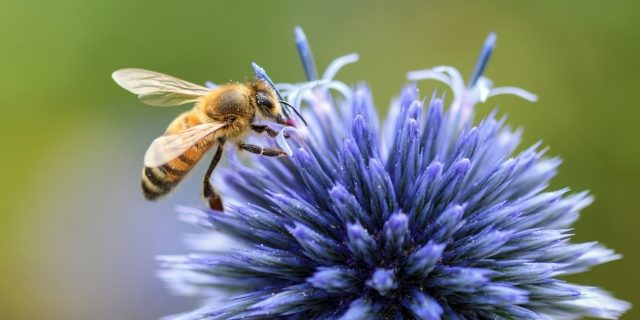23
Aug
Wasted: Bees Become Disoriented and Uncoordinated After Exposure to Systemic Pesticides

(Beyond Pesticides, August 23, 2022) Bees exposed to systemic insecticides become disoriented and cannot walk straight, showing evidence of brain damage in areas that coordinate movement, according to research published in Frontiers in Insect Science. Although scientific studies and regulatory determinations have already provided ample evidence implicating systemic insecticides like the neonicotinoids and sulfoxaflor with pollinator danger and decline, new research continues to fill in the remaining gaps. “Here we show that commonly used insecticides like sulfoxaflor and the neonicotinoid imidacloprid can profoundly impair the visually guided behavior of honey bees,” said lead author Rachel H Parkinson, PhD, a scientist at the University of Oxford. “Our results are reason for concern because the ability of bees to respond appropriately to visual information is crucial for their flight and navigation, and thus their survival.”
Honey bees rely on landmarks, the direction of sunlight, and wide-field visual motion to orient themselves in a landscape, find nectar and pollen, and bring it back to the hive. While sunlight provides a compass, wide-field visual motion helps bees adjust speed and altitude, and determine where they are relative to known landmarks. Worker bees use this innate ability to reorient themselves to food or their hive should they ever veer off course.
To test how pesticides impact this process, scientists employed an optomotor assay. Worker bees were placed on a small ball in a virtual arena and exposed to videos of vertical bars that shifted left to right, mimicking a worker bee getting blown off their course. Four groups of worker forager bees captured as they were returning to their hive in Falmouth, Maine were tested in this virtual arena. Prior to the test, one group was exposed to 50 parts per billion (ppb) of imidacloprid, one to 50 ppb of sulfoxaflor, another to 25ppb of imidacloprid and 25ppb of sulfoxaflor, with the last group acting as an unexposed control. Exposed bees were evaluated for how well they reorient after the visual disturbance.
All worker honey bees exposed to insecticides displayed asymmetrical responses. In other words, contaminated pollinators were only able to respond to visual stimuli coming from a single direction. According to the study, the asymmetry between left and right turns was more than 2.4 times greater for the pollinators subjected to systemic insecticides than those left unexposed.
In hopes of further understanding what is occurring in bee brains under these conditions, researchers took another four groups of workers and treated them with the same amount of insecticide as those that underwent the optomotor assay. Pollinators from these groups then had their brains dissected for analysis. Genes that help honey bees detoxify after chemical exposure showed decreased expression after imidacloprid treatment. Sulfoxaflor exposure revealed evidence of damage to brain cells in the optic lobes. “Neonicotinoid and sulfoximine insecticides activate neurons in the insect brain and are not always recycled fast enough to prevent toxicity. The effects we observed could be due to a type of rewiring in the brain: to prevent neural damage by reducing the sensitivity of neurons to these compounds,” said Dr. Parkinson.
The same research team found in 2019 that neonicotinoid exposure had significant impacts on the visual field of locusts, with implications that similar results would be seen in other insects, like bees and other pollinators. “Like any organism, the sensory system enable the bee to function. If the brain function, as this study finds, is altered, the organism cannot function normally,” Jay Feldman, executive director of Beyond Pesticides wrote to Salon in a comment on the current study. “We know that similar effects to the nervous system occur in people with similar vulnerabilities.”
Worker bees getting blown off course and unable to find their way back to the hive was the defining aspect of Colony Collapse Disorder, a term which has since fallen out of favor as beekeepers have since experienced variety of differently characterized hive losses. Yet, declines in both wild and managed pollinators continues to this day, with 2021 marking the second highest honey bee losses recorded. “The major concern is that – if bees are unable to overcome any impairment while flying – there could be profound negative effects on their ability to forage, navigate, and pollinate wildflowers and crops,” said Dr. Parkinson.
We cannot continue to sit back as pollinators die and the data linking these deaths to pesticide exposure continues to pile up. To stop and reverse pollinator declines, we must stop EPA from registering pesticides that harm these critical species. The Saving America’s Pollinators Act (SAPA) does this, establishing a board of experts who make determinations over pesticide use that poses a danger to pollinators. Join us today in promoting pollinator protection and urging your member of Congress to cosponsor SAPA.
All unattributed positions and opinions in this piece are those of Beyond Pesticides.
Source: Frontiers in Insect Science (peer reviewed study), Frontiers in Insect Science (science news)











MWN CANNOT LIVE WITHOUT BEES THATA POLLINATE AND HELP US TO PLANT AND GROW OUR FOODS AND CROPS. THERE HAS TO BE A BETTER WAY THEN THE USE OF PESTICIDES. OR WE WILL ALL PERISH.
August 24th, 2022 at 11:00 pmAll the scientific evidence is pointing to toxic pesticides as the cause of bee colony decline. Toxic pesticides (many of which are banned in Europe & UK) are not banned in the US. The question is “Why Not?”!! To restore bee health and to protect our food system for future generations and for ourselves, we have to do ALL we can now to restore the health of our bees. We need to BAN these pesticides immediately and let nature and organic farming lead the way.
August 25th, 2022 at 6:11 amPlease put planet and people before profit. Please act responsibly and with integrity towards the our environment and our bees.